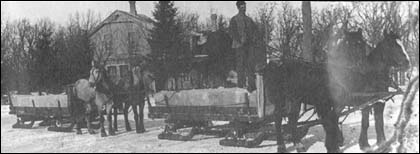
The author, Connie Williams, is doing graduate work in history at St. Cloud State University and has worked at the Paynesville Area Museum for several summers.
 |
(Editor's note: For the next year, we will present a series of articles that examine the years around 1900. Our purpose is to provide a comparison of the beginning of the 20th Century to its upcoming end. The author, Connie Williams, is doing graduate work in history at St. Cloud State University and has worked at the Paynesville Area Museum for several summers.
|
Young people today do not know what an icebox is. They come to the Paynesville Area Museum and see one and they not only don't know what it is, but it is a new concept to them.
They can't imagine using lake ice either. They can't imagine lake water being so pure. So pure, you could look right through a 300-pound cake of ice.
We can no longer see, but can only imagine what it was like to see horses on a cold, cold morning, snorting with their breath hanging in the air as they pulled a sled load of ice. Men, dedicated and strong, pulled the ice out of the water.
In our zeal to look ahead to a new century it is easy to forget our past. We don't want to forget these important images or what these people gave us.
Harvesting Ice
Alvin "Bub" Hartmann's family - Hartmann's Ice Company - began in the ice business 100 years ago, near the turn of the last century.
Originally, Bub Hartmann's grandfather Leo helped North American Cold Storage Company with cutting and packing ice. This was around 1900. A few years later, Leo Hartmann also began an ice business, which he later turned over to his son Raymond. After he returned from service in World War II, Alvin, Raymond's son, took over the business.
One can hardly appreciate the hard work involved in ice harvesting. The next time that you enjoy the convenience of your refrigerator or pop an ice cube into a drink, think about this story. Not only children, but also many adults today do not realize that it was like to live during a time before electrification.
Drift back a moment to a time when nights were truly dark and life was hard.
In the early days of ice cutting, the snow had to be cleared off the ice on the lake with horses and scrapers. The ice was cut with a device called an ice plow. Pulled by two horses, the plow had a series of four cutting knives attached to a steel beam. Two wooden handles fastened to the beam permitted the person following it to guide the plow. Several passes across the ice along the same path were necessary. The indentation made by the plow was about 12 inches deep. The job was then finished with either a hand saw or a chisel.
They tried to make ice in the month of January, but Bub said in later years it always got into February. They liked to have the ice over 20 inches thick. If there was too much cold weather then it got 30 inches thick and it was hard to handle.
They first cut the ice with a power saw in 1922. The year Bub Hartmann was born. A Model T Ford had a wreck and Bub's father, Ray, purchased it. He and Al Drakenberg turned the engine into a power saw.
The average chunk of ice weighed 300 pounds. If the whole crew cut they would put out over a thousand cakes. Lake Henry, Spring Hill, and Farming used to haul ice from here, too.
First, you broke off a row of ice, then you broke off a "cake." A "cake" was a block of ice. The cake would float in the water. Long poles were used to direct it to a platform where it would be pulled up. Large tongs were used to pull ice to the platform. Hooks with handles were attached to a team of horses to pull up cakes of ice onto the platform. A cake was slid on a ramp with a ditch of water for a runway. Eight cakes were slid up to a rack on a sled and then hauled to the ice house. Some sleds had flat beds and some had racks.
 The sleds carried the ice from Lake Koronis to Paynesville, where the ice was stored. Then in 1919, the sleds and horses were replaced with a truck. At left is an old picture of the ice sled and horses as they deliver ice.
The sleds carried the ice from Lake Koronis to Paynesville, where the ice was stored. Then in 1919, the sleds and horses were replaced with a truck. At left is an old picture of the ice sled and horses as they deliver ice.
The Ice House
At the ice house, the cakes were stacked tightly together. The ice was stacked by horses and pulleys. Men with tongs helped to stack them very tightly in the house. Seven inches were left between the outside wall and the ice.
When they got the ice nearly to the roof, they put sawdust on top, too. The ice stayed frozen all year. The ice stayed frozen all year. The ice stayed in a pristine condition as well. It would come out just like the day it was put in there. You could still see where they shaved the edges. Bub said there were times when the ice at the bottom of the ice house was 10 to 15 years old!
In the fall of the year, they had to go in and shovel all the sawdust out, because if it froze they had to chop it out. If the ice house was completely empty they could flood the floor like a skating rink and then just slid the ice right in.
They used nothing but pine sawdust. Any other hardwood sawdust would turn to dirt. Hartmann had cousins up in northern Minnesota, who would locate a saw mill in the woods. The pine sawdust could be used for three or four years. It has something like turpentine in it, and it doesn't rot.
Delivery
In early years, they delivered to private homes every other day with ice for the icebox. They went to businesses every day. They used to deliver a lot of ice to the creamery, as they had an ammonia freezer for ice cream. Hartmanns had to chip all the ice and pack it around the ice cream. They would also deliver ice to beer joints around the countryside.
They made ice on Rice Lake for quite a few years to give to the resorts. They delivered to five of six resorts on Rice Lake. They made deliveries to a few resorts near Paynesville.
In the summer, they would deliver ice to cottages on Monday, Wednesday, and Saturday in the late afternoon.
Kids would always run after the ice man for a chip of ice.
Ray Hartmann used coupon books. The coupon would say "Good for 50 lbs. of ice," for example. They sold a lot of pieces of ice for 10 or 20 cents.
The end of an era
Hartmanns quit making ice the winter of 1977, because of electric refrigeration. It became too much work for the money they made. The last years that they made ice, most of the ice was put into produce trailers that hauled to the east coast.
Hartmann's Ice Company today makes cubes of ice with machines, but they made lake ice cubes for awhile. They cut the ice by hand into one-inch cubes. They were used for the VFW or the Legion for their drinks.
(Next month's feature will compare past and present Valentine's Day traditions. )